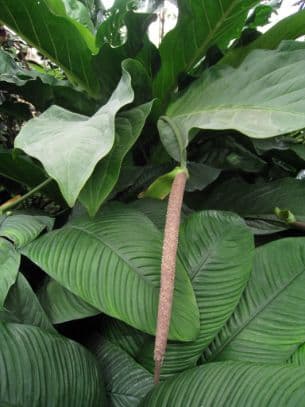Calla Lily Zantedeschia 'Cantor' (PBR)

ABOUT
The Zantedeschia 'Cantor', commonly known as Calla Lily 'Cantor', is an elegant perennial plant known for its striking dark flowers that resemble fluted cups. The blooms are a deep, velvety purple-black shade, almost appearing chocolate in color. These flowers are made up of a spathe, the funnel-like bract that wraps around the central spadix which may be a contrasting color. The plant's leaves are broad and arrow-shaped, typically a lustrous green, providing a lush backdrop for the dramatic inflorescences. The foliage sometimes showcases white or lighter colored spots, adding interest to the overall appearance of the Calla Lily 'Cantor'. Its graceful form and rich coloring make it a favorite for ornamental plantings and floral arrangements.
About this plant
 Names
NamesFamily
Araceae
Synonyms
Calla Lily, Arum Lily
Common names
Zantedeschia 'Cantor' (PBR)
 Toxicity
ToxicityTo humans
The Calla Lily, specifically the Zantedeschia 'Cantor', is toxic to humans if ingested. Poisoning symptoms include irritation of the mouth and throat, nausea, vomiting, and diarrhea. The presence of oxalate crystals in the plant can cause swelling and a burning sensation, leading to significant discomfort and potential health issues.
To pets
Similar to its effects on humans, the Calla Lily ('Cantor' variety) is also poisonous to pets, including dogs and cats. Symptoms of poisoning can include drooling, vomiting, difficulty swallowing, and oral irritation. The calcium oxalate crystals found in the plant can cause severe symptoms and may lead to serious, potentially fatal, consequences if not treated promptly.
 Characteristics
CharacteristicsLife cycle
Perennials
Foliage type
Evergreen
Color of leaves
Green
Flower color
Dark purple
Height
2 feet (60 cm)
Spread
2 feet (60 cm)
Plant type
Herb
Hardiness zones
9
Native area
South Africa
Benefits
 General Benefits
General Benefits- Elegant Aesthetic: The Zantedeschia 'Cantor', commonly known as Calla Lily 'Cantor', offers a sophisticated and elegant floral display with its deep purple, almost black flowers, which can enhance the visual appeal of any garden or indoor space.
- Easy to Grow: Calla Lily 'Cantor' is known for being relatively easy to grow, which makes it suitable for gardeners of all experience levels.
- Long Flowering Period: This plant typically has a long flowering period that can extend through the summer giving a garden enduring beauty.
- Attracts Pollinators: Its blooms can attract beneficial pollinators such as bees and butterflies to your garden, which are essential for the pollination of many plants.
- Versatile Usage: The Calla Lily 'Cantor' can be used in a variety of garden settings, including borders, pots, and as cut flowers for indoor decoration.
- Low Maintenance: This variety of Calla Lily generally requires minimal maintenance once established, which can save time and effort for the gardener.
- Drought Tolerant: Once established, the plant can withstand periods of drought, making it suitable for drier climates or water-wise gardens.
 Medical Properties
Medical PropertiesThis plant is not used for medical purposes.
 Air-purifying Qualities
Air-purifying QualitiesThis plant is not specifically known for air purifying qualities.
 Other Uses
Other Uses- Art Inspiration: The striking appearance of the Calla Lily 'Cantor' can serve as a muse for artists and photographers, inspiring botanical artwork and stunning floral photographs.
- Wedding Themes: Calla Lily 'Cantor' is often used as a motif for weddings, from invitations and decorations to bridal bouquets, thanks to its elegant shape and deep purple hues.
- Culinary Garnish: Although not edible, the Calla Lily 'Cantor' can be used as a non-toxic garnish for plating in high-end culinary presentations, adding beauty and sophistication to dishes.
- Fashion and Textile Prints: The unique form of the Calla Lily 'Cantor' can inspire patterns for fashion and home textiles, imbuing fabrics with a touch of floral elegance.
- Educational Tool: Botany teachers may use Calla Lily 'Cantor' as an example to educate students about plant anatomy and pollination, as its flowers reveal interesting structures like the spadix and spathe.
- Biodegradable Confetti: Petals of the Calla Lily 'Cantor' could be used as a natural and biodegradable confetti for celebrations, lessening the environmental impact compared to traditional paper or plastic confetti.
- Scented Arrangements: Although not known for a strong fragrance, Calla Lily 'Cantor' can be included in scented bouquets to add visual impact without altering the intended aroma.
- Property Value Enhancement: Incorporating Calla Lily 'Cantor' in residential landscaping can boost curb appeal and potentially increase property values with its visually appealing aesthetic.
- Artisan Crafts: Dried or pressed Calla Lily 'Cantor' petals can be used in making bookmarks, greeting cards, or other crafted items, providing a delicate and unique touch.
- Color Inspiration: The deep purple of the Calla Lily 'Cantor' can provide a color palette for interior designers and homeowners looking to decorate spaces with rich, vibrant tones.
Interesting Facts
 Feng Shui
Feng ShuiThe Calla Lily is not used in Feng Shui practice.
 Zodiac Sign Compitability
Zodiac Sign CompitabilityThe Calla Lily is not used in astrology practice.
 Plant Symbolism
Plant Symbolism- Purity and Innocence: Typically associated with white calla lilies, the 'Cantor' shares this symbolism as its dark blooms still evoke a sense of cleanliness and untainted beauty.
- Beauty: The 'Cantor', much like other calla lilies, is often used to represent beauty due to its elegant and unique form.
- Faith and Spirituality: Calla Lilies are sometimes used in religious contexts, symbolizing faith and purity, particularly within Christianity as they are associated with the Virgin Mary.
- Rebirth and Resurrection: The lily’s role in Easter services as a representation of Christ's resurrection gives it a symbolism of new life and rebirth.
- Marriage and Devotion: Because of their beauty and association with purity, calla lilies are commonly used in weddings to represent devotion and marital bliss.
- Transcendence: The striking appearance of the 'Cantor' calla lily conveys a sense of transcendence and overcoming difficult obstacles.
 Water
WaterCalla lilies, like the Zantedeschia 'Cantor', should be watered deeply once a week during their growing season, allowing the soil to dry between waterings to avoid waterlogging. The amount needed per watering can generally be around 1 gallon for outdoor plants or 16-24 ounces for potted indoor plants, depending on the size and the environmental conditions. During their dormancy period in winter, reduce watering to every other week or less, monitoring the soil moisture.
 Light
LightCalla lilies prefer bright, indirect light and should be placed in a spot that receives filtered sunlight for most of the day. Direct afternoon sun can be too intense and may scorch the leaves, so a location with morning sun or dappled light is ideal. They can tolerate some degree of partial shade, but too little light may hinder bloom production.
 Temperature
TemperatureThe Calla lily thrives at temperatures between 60 to 75 degrees Fahrenheit and should be protected from temperatures below 50 degrees Fahrenheit to prevent damage. The maximum temperature they can tolerate is around 85 degrees Fahrenheit, but consistently high temperatures may stress the plant. They are not frost-tolerant and should be moved indoors or protected if outdoor temperatures are expected to drop below 50 degrees.
 Pruning
PruningPruning Calla lilies is done mainly to remove spent flowers and yellowing leaves to encourage further blooms and maintain plant health. Deadheading, or cutting off the dead flower stalks, can be performed after blooming, typically in late summer or early fall. Pruning should be done carefully with clean, sharp scissors or pruners to prevent damage to the plant.
 Cleaning
CleaningAs needed
 Soil
SoilThe Calla Lily 'Cantor' thrives in well-draining, rich potting mix with a peat moss base. The ideal soil pH for this plant is between 5.5 and 6.5.
 Repotting
RepottingCalla Lily 'Cantor' should ideally be repotted every year after flowering, when the plant begins to outgrow its container or starts to look overcrowded.
 Humidity & Misting
Humidity & MistingCalla Lily 'Cantor' prefers a high humidity environment, around 60-70%, to thrive and produce its elegant blooms.
 Suitable locations
Suitable locationsIndoor
Place in bright, indirect light with high humidity.
Outdoor
Plant in partial shade, moist, well-drained soil.
Hardiness zone
8-10 USDA
 Life cycle
Life cycleZantedeschia 'Cantor' (PBR), commonly known as Calla Lily 'Cantor', begins its life cycle as a rhizome, which sprouts roots and shoots upon exposure to appropriate soil temperatures and moisture levels. The shoots develop into erect, stem-like structures bearing large, arrow-shaped leaves and eventually produce the plant's characteristic funnel-shaped flowers, usually during the late spring to summer months. After flowering, the plant undergoes a period of seed production if pollination has occurred, leading to the development of small berries that contain seeds. As the growing season ends, the Calla Lily 'Cantor' enters a dormant phase, particularly in cooler climates, where the foliage will die back and the plant will survive underground as a rhizome. Environmental cues such as reduced daylight and cooler temperatures trigger this dormancy. The cycle repeats when warmer temperatures and increasing daylight in the following spring stimulate the rhizome to resume growth, starting a new cycle of vegetation and flowering.
 Propogation
PropogationPropogation time
Spring-Early Summer
Zantedeschia 'Cantor' (PBR), commonly known as Calla Lily 'Cantor', is most commonly propagated through division, which is best done in late winter or early spring before new growth begins. To propagate by division, carefully unearth the rhizomes and gently separate them, ensuring each division has at least one eye, or bud, from which new growth can emerge. Replant the divisions promptly, generally spacing them about 12 inches (or 30 centimeters) apart, at a depth of 3 to 4 inches (about 7 to 10 centimeters) in soil that has been well-amended with organic matter. Keep the soil evenly moist and provide a location with full to partial sunlight. This method promotes a straightforward way to create new plants that will be genetically identical to the parent, thus preserving its unique characteristics.









